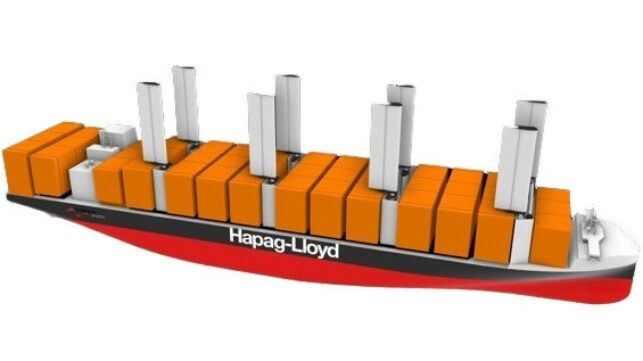Hapag-Lloyd Leverages Yacht Racing to Study Wind-Assisted Propulsion

Hapag-Lloyd is working to leverage the experience of a world-class racing yacht team as it works to explore the potential of sails for wind-assisted propulsion on its containerships. The project, which has been underway since the beginning of 2023, is researching the pros and cons of the system in an effort to demystify wind propulsion and determine the financial viability for container shipping.
Some segments of shipping, such as bulkers and tankers, have been at the forefront of wind-assisted propulsion, but containerships with the need to maximize containers loaded have lagged. Hapag points to issues that it is exploring ranging from the impact on operations to the need for training, and regulations. They are exploring the financial considerations of the cost of installing the systems versus the fuel saving, as well as the physical space needs, and the impact of the flexibility of routes and vessels using wind-assisted propulsion technology.
Hapag is working with Boris Herrmann and Team Malizia which in May 2023 during the annual The Ocean Race set a world record for the distances traveled by a monohull vessel. They have completed the first phase of the project working on the conceptual design of a 4,500 TEU ship and they expect to finish the concept study in the next few months. HAPAG is not the first to enlist the experience from the racing yacht universe as UK-based BAR Technologies was launched with the experience from ocean racing and is working to commercialize a wind-wing concept that has already been ordered for a few ships. Ocean Network Express (ONE) also recently revealed plans to test wind-assisted propulsion using a portable wind sail that is carried inside a container-sized assembly.
Christoph Thiem, Director Strategic Assets Projects, and Martin Köpke, Manager Regulatory Affairs & Sustainability, for Hapag, highlighted that much of the carrier’s focus in recent years has been on fuel combustion to maximize efficiency. Now they are examining various alternative fuels.
“The challenge right now is fuel availability, and we won’t be able to tackle this challenge without R&D,” notes Köpke. “What will drive us in the years ahead will be new alternative fuels. These aren’t available yet in the needed quantities and will initially be very expensive.”
Hapag is looking at alternative technologies on board its ships that could reduce fuel consumption to help address the anticipated challenges with alternative fuels. Their wind-assisted propulsion concept is for a newbuild with eight sails for a total of 3,000 square meters (more than 32,000 square feet) of sail area. The six rear sails would be extendable and the two front sails would be retractable so as not to hinder cargo operations and the navigation capabilities of the ship.
“Some shipping companies have come up with concept designs for wind-powered containerships that look very futuristic,” says Köpke. “But, to me, our designs seem more realistic.”
In the second phase of the current research, the Hapag partnership is using computer simulations to study how the ship would behave in weather conditions as well as how much fuel could be saved. They are using different scenarios, such as speed, sailing much slower, and drafts, as well as considerations such as how the ship would handle when it isn’t fully loaded.
One concept that they are exploring is the ability of the ship at slow speeds of 8 to 10 knots and the right wind conditions to be propelled using just the sail system. They admit however that they have not yet explored all aspects of this concept.
They are also studying historical weather data for their Conosur route which sails around South America and will also look at other shipping routes. They believe the vessel would be better suited to some routes but need to understand the factors to determine which routes and the level of benefits.
Another key consideration will be the changing cost of alternative fuels. Near-term they anticipate high costs which could contribute to the benefits of wind-assisted propulsion. They note fuel costs might decline and the economic profile for wind-assisted propulsion might look different in five years.
With the current project, Hapag reports it is gathering quantifiable data for wind-assisted propulsion which will give it a basis for the next steps.
